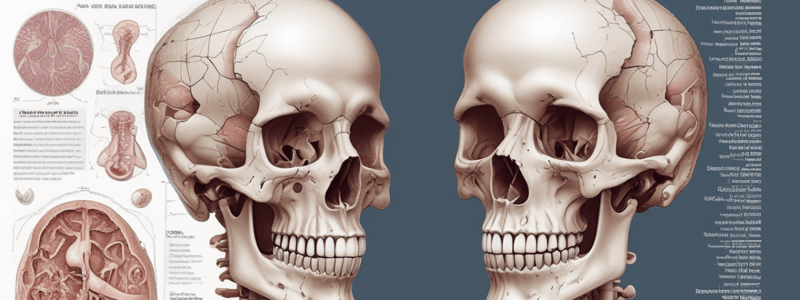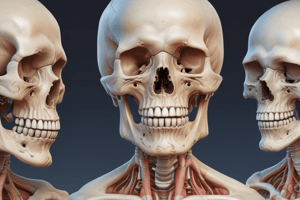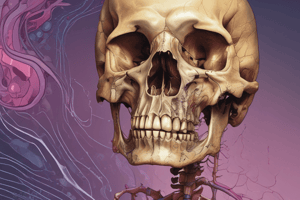Podcast
Questions and Answers
What is the key factor in determining whether a bone tumor is benign or malignant based on cellular features?
What is the key factor in determining whether a bone tumor is benign or malignant based on cellular features?
- Presence of inflammation
- Anatomical location
- Rate of growth (correct)
- Production of hormones
In the context of bone tumors, what is the significance of 'location' according to the text?
In the context of bone tumors, what is the significance of 'location' according to the text?
- Indicative of the patient's age
- Determines the necessity of surgical intervention
- Affects the likelihood of the tumor being benign or malignant (correct)
- Influences the choice of imaging studies
Why are osteomas considered rare benign tumors according to the text?
Why are osteomas considered rare benign tumors according to the text?
- They are difficult to diagnose
- They often cause systemic issues
- They always lead to severe symptoms
- They are typically asymptomatic (correct)
Which bone tumor is predominantly located at the epiphysis of bones?
Which bone tumor is predominantly located at the epiphysis of bones?
What is a common feature shared by fibrous dysplasia and aneurysmal bone cysts?
What is a common feature shared by fibrous dysplasia and aneurysmal bone cysts?
Why is considering the cellular appearance crucial in determining the nature of a bone lesion?
Why is considering the cellular appearance crucial in determining the nature of a bone lesion?
Which bone tumor is characterized by being relieved by aspirin?
Which bone tumor is characterized by being relieved by aspirin?
Which bone tumor is known as the 'giant osteoid osteoma'?
Which bone tumor is known as the 'giant osteoid osteoma'?
Which bone tumor has an identical histologic appearance to osteoid osteoma?
Which bone tumor has an identical histologic appearance to osteoid osteoma?
In which age group does osteosarcoma commonly occur?
In which age group does osteosarcoma commonly occur?
Which bone tumor produces osteoid and can sometimes make cartilage?
Which bone tumor produces osteoid and can sometimes make cartilage?
What is the most common primary malignant tumor of bone?
What is the most common primary malignant tumor of bone?
What is the significance of the 'location, location, location' phrase in relation to bone tumors?
What is the significance of the 'location, location, location' phrase in relation to bone tumors?
What distinguishes an osteoma from other bone tumors?
What distinguishes an osteoma from other bone tumors?
Why are chondromyxoid fibromas considered distinct among cartilage-forming bone tumors?
Why are chondromyxoid fibromas considered distinct among cartilage-forming bone tumors?
What factor is crucial in determining whether a bone lesion is benign or malignant based on cellular features?
What factor is crucial in determining whether a bone lesion is benign or malignant based on cellular features?
In terms of bone tumors, what does the pattern of growth help determine?
In terms of bone tumors, what does the pattern of growth help determine?
What differentiates fibrous dysplasia from osteoid osteoma based on radiographic appearance?
What differentiates fibrous dysplasia from osteoid osteoma based on radiographic appearance?
What is a distinguishing feature between osteoid osteoma and osteoblastoma in terms of pain relief?
What is a distinguishing feature between osteoid osteoma and osteoblastoma in terms of pain relief?
Which bone tumor is characterized by a central radiolucent nidus surrounded by a sclerotic rim on X-ray?
Which bone tumor is characterized by a central radiolucent nidus surrounded by a sclerotic rim on X-ray?
What is the distinguishing radiological feature between osteoblastoma and osteosarcoma?
What is the distinguishing radiological feature between osteoblastoma and osteosarcoma?
Which bone tumor is the most common primary malignant tumor of bone?
Which bone tumor is the most common primary malignant tumor of bone?
In which age group do osteoblastomas typically occur?
In which age group do osteoblastomas typically occur?
What is a distinguishing characteristic between osteosarcoma and both osteoid osteoma and osteoblastoma?
What is a distinguishing characteristic between osteosarcoma and both osteoid osteoma and osteoblastoma?
What aspect of a bone lesion is crucial in determining if it is more likely benign or malignant?
What aspect of a bone lesion is crucial in determining if it is more likely benign or malignant?
Which bone tumor exhibits a central radiolucent nidus surrounded by a sclerotic rim on X-ray?
Which bone tumor exhibits a central radiolucent nidus surrounded by a sclerotic rim on X-ray?
What is a distinguishing histologic feature of osteoid osteoma that sets it apart from other bone tumors?
What is a distinguishing histologic feature of osteoid osteoma that sets it apart from other bone tumors?
In the context of bone tumors, what is the significance of the 'location, location, location' phrase?
In the context of bone tumors, what is the significance of the 'location, location, location' phrase?
Which bone tumor is known as the 'giant osteoid osteoma' due to its similar histologic appearance?
Which bone tumor is known as the 'giant osteoid osteoma' due to its similar histologic appearance?
'Location, location, location' in relation to bone tumors primarily refers to:
'Location, location, location' in relation to bone tumors primarily refers to:
Which bone tumor is most likely to have a radiolucent nidus and less or no sclerotic rim on X-ray?
Which bone tumor is most likely to have a radiolucent nidus and less or no sclerotic rim on X-ray?
In which age group is osteoblastoma most commonly seen?
In which age group is osteoblastoma most commonly seen?
What is the distinguishing feature between osteoid osteoma and osteosarcoma in terms of pain?
What is the distinguishing feature between osteoid osteoma and osteosarcoma in terms of pain?
Which bone tumor is characterized by producing osteoid and sometimes cartilage?
Which bone tumor is characterized by producing osteoid and sometimes cartilage?
What is the most common primary malignant tumor of bone?
What is the most common primary malignant tumor of bone?
Which bone tumor is known as the 'giant osteoid osteoma'?
Which bone tumor is known as the 'giant osteoid osteoma'?
What differentiates osteoid osteoma and osteoblastoma in terms of pain relief?
What differentiates osteoid osteoma and osteoblastoma in terms of pain relief?
Which bone tumor shares an identical histologic appearance with osteoblastoma?
Which bone tumor shares an identical histologic appearance with osteoblastoma?
What is a distinguishing radiological feature of osteosarcoma compared to osteoid osteoma and osteoblastoma?
What is a distinguishing radiological feature of osteosarcoma compared to osteoid osteoma and osteoblastoma?
What is a unique characteristic of the radiological appearance of osteoblastoma compared to other bone tumors?
What is a unique characteristic of the radiological appearance of osteoblastoma compared to other bone tumors?
In terms of size, what differentiates osteoid osteoma from osteoblastoma?
In terms of size, what differentiates osteoid osteoma from osteoblastoma?
What is a distinguishing characteristic between osteosarcoma and both osteoid osteoma and osteoblastoma?
What is a distinguishing characteristic between osteosarcoma and both osteoid osteoma and osteoblastoma?
What aspect is crucial in determining if a bone lesion is more likely benign or malignant based on cellular features?
What aspect is crucial in determining if a bone lesion is more likely benign or malignant based on cellular features?
What is the primary factor in determining whether a bone lesion is benign or malignant?
What is the primary factor in determining whether a bone lesion is benign or malignant?
Which bone tumor is predominantly located at the diaphysis of bones?
Which bone tumor is predominantly located at the diaphysis of bones?
What sets osteoma apart from other bone tumors?
What sets osteoma apart from other bone tumors?
In terms of radiographic appearance, what feature distinguishes fibrous dysplasia from osteoid osteoma?
In terms of radiographic appearance, what feature distinguishes fibrous dysplasia from osteoid osteoma?
Which bone tumor is characterized by being relieved by aspirin?
Which bone tumor is characterized by being relieved by aspirin?
What does the phrase 'location, location, location' primarily refer to in the context of bone tumors?
What does the phrase 'location, location, location' primarily refer to in the context of bone tumors?
What characteristic differentiates osteoid osteoma from osteoblastoma in terms of pain relief?
What characteristic differentiates osteoid osteoma from osteoblastoma in terms of pain relief?
What is the distinguishing characteristic of the radiological appearance of osteosarcoma compared to osteoid osteoma and osteoblastoma?
What is the distinguishing characteristic of the radiological appearance of osteosarcoma compared to osteoid osteoma and osteoblastoma?
What is a distinguishing feature of the histologic appearance of both osteoid osteoma and osteoblastoma?
What is a distinguishing feature of the histologic appearance of both osteoid osteoma and osteoblastoma?
Which bone tumor has a bimodal age distribution and is most common as a primary malignant tumor of bone?
Which bone tumor has a bimodal age distribution and is most common as a primary malignant tumor of bone?
In contrast to osteoid osteoma, which bone tumor exhibits a central radiolucent nidus surrounded by a sclerotic rim on X-ray?
In contrast to osteoid osteoma, which bone tumor exhibits a central radiolucent nidus surrounded by a sclerotic rim on X-ray?
What characteristic differentiates the pain relief pattern between osteoid osteoma and osteosarcoma?
What characteristic differentiates the pain relief pattern between osteoid osteoma and osteosarcoma?
Flashcards are hidden until you start studying
Study Notes
Bone Tumors: Characteristics and Classification
Osteoma
- Rare benign tumor of mature bone
- Age: 40-50 years old
- Site: cortical bones of skull and face
- X-ray: well-delimited nodule
- Prognosis: good (simple excision), slow-growing, not invasive, no malignant transformation
- May cause local and mechanical problems (e.g. sinus obstruction; osteoma in endosteal surface of brain)
Osteoid Osteoma & Osteoblastoma
- Benign neoplasms with identical histology
- Differ in size, sites of origin, X-ray features, and symptoms
- Osteoblastoma = "giant osteoid osteoma"
- X-ray: central area of tumor (nidus); usually radiolucent, surrounded by rim of sclerotic bone
- Both painful lesions, but pain is relieved by aspirin in osteoid osteoma, not in osteoblastoma
Osteoblastoma
- Age: teens to twenties
- Site: vertebral column, other
- Size: > 2 cm
- X-ray: radiolucent nidus, less (or no) sclerotic rim
- Prognosis: good, if totally excised
- Histologic appearance: interlacing trabeculae of woven bone surrounded by osteoblasts; loose connective tissue stroma (no marrow elements); may see giant cells
- Pain not relieved by aspirin
Osteosarcoma
- Malignant mesenchymal tumor
- Neoplastic cells produce osteoid (unmineralized bone matrix); sometimes makes cartilage
- Most common 1° malignant tumor of bone (20% of 1° bone malignancies)
- M:F = 1.6:1
- Bimodal age distribution: 75% occur in patients
General Locations of Bone Tumors
- Diaphysis: Ewing sarcoma, chondrosarcoma
- Metaphysis: osteosarcoma
- Physis: giant cell tumor
- Epiphysis: various tumors
Systematic Approach to Bone Tumors
- What is the lesion's pattern of growth?
- Are the cells of the lesion producing anything?
- What do the cells of the lesion look like?
- Based on cellular features and imaging studies, is the lesion more likely benign or malignant?
- Does the anatomical diagnosis (i.e. pathology) correlate with the clinical picture and radiographic appearance of the lesion?
Studying That Suits You
Use AI to generate personalized quizzes and flashcards to suit your learning preferences.




